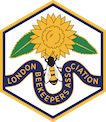
|
London Beekeepers' Association |

|
London Beekeepers' Association |
Sep in the Apiary[In the apiary, month by month.] Howard Nichols September's work should be about putting the bees in the best position to survive through winter. The bee population will continue to decline in September but the new bees now being born will need to live through to next April, for 6 months instead of 6 weeks. They need to be healthy, free of varroa mites and associated viruses and with plenty of stores. Those members who diligently applied Apiguard or another proprietary varroacide throughout August should now be the proud custodians of newly born healthy bees. Feeding the colonyThis is the main job for September. A full sized colony needs to have 35lb of stores to see it through to next April. A National brood frame holds 5lbs and so the equivalent of 7 frames is needed. If, say, you estimate 5 frames of honey is currently in the hive then this is 25lb and a further 10lb is required. 1lb. of sugar will make 1.25lb of honey (honey is 80% sugars and 20% water). Therefore, using this example syrup should be made from 8lb of sugar to complete the stores. Any surplus will not be wasted as it will be used by the bees next spring. Feeding fondant in winter causes the cluster to break up and is an unnecessary disturbance. It is preferable to feed in September and so ensure that there are sufficient stores for the winter. Fondant in winter should only be used as an emergency feed, not part of a planned strategy. The best time for winter and spring feeding is always in the preceding autumn! If feeding is left until October then, due to cooler temperatures, the bees may be unable to evaporate down the water content to less than 20% and then cap the stores. This is likely to lead to the syrup fermenting over the winter period. All feeding should be completed by the end of September. Sugar must be white granulated sugar. Any other sugar is harmful to the bees. A stronger syrup should be used at this time of year as this means the bees have less work to do in evaporating off the water. This syrup is not for immediate consumption but for winter and early spring stores. 1kg of sugar dissolved in 660ml of warm water is the desired strength. If the feeder needs to be topped up then it is essential to wear a veil. Bees may not appear to be very active if late in the month and cooler but they will surge through the feedhole if the feeder is disturbed or taken off. Other action to be taken this monthMarking the queen. If the colony has a new queen born this summer then now is the best time to find and mark her. The colony is contracting with the brood limited to just a few frames and this makes it a much easier proposition. If the queen is marked then next season's swarm control will be so much easier. Checking the hive. Hive body should be level, draught free and the roof should be waterproof. Now is the time to replace any defective or ill fitting equipment before the onset of winter. Protecting against wasps and robbers. Entrance blocks must be in situ. Many beekeepers reduce the entrances to as little as 2 or 3 bee spaces. If a colony is being robbed it is extremely difficult to stop. Fumigate supers. These should have been fumigated immediately after having been returned to the bees for cleaning and removed again. Fumigated supers should be put in a place secure from wax moth and vermin. Mouseguards. If it starts to turn cold then these should be fitted late in the month or in early October. However, this is usually an October job. |
©2025 London Beekeepers' Association |